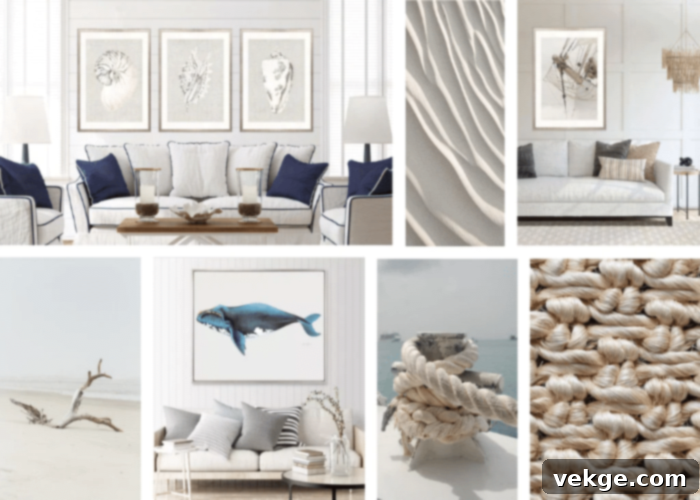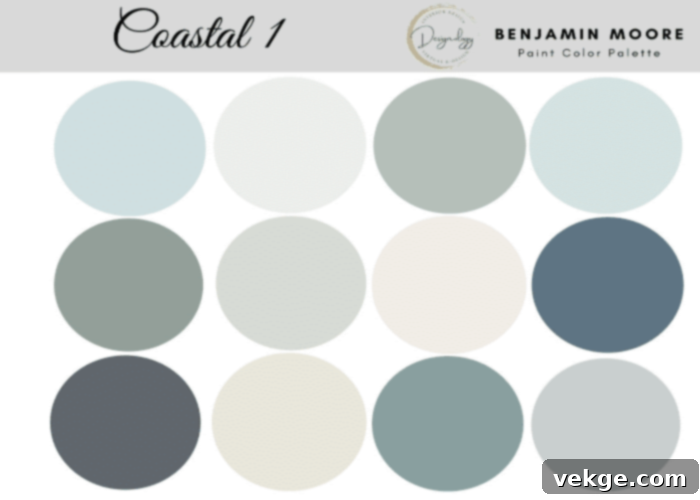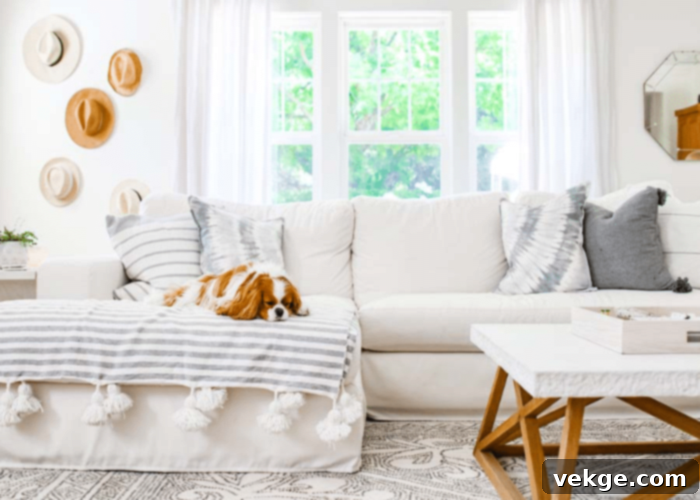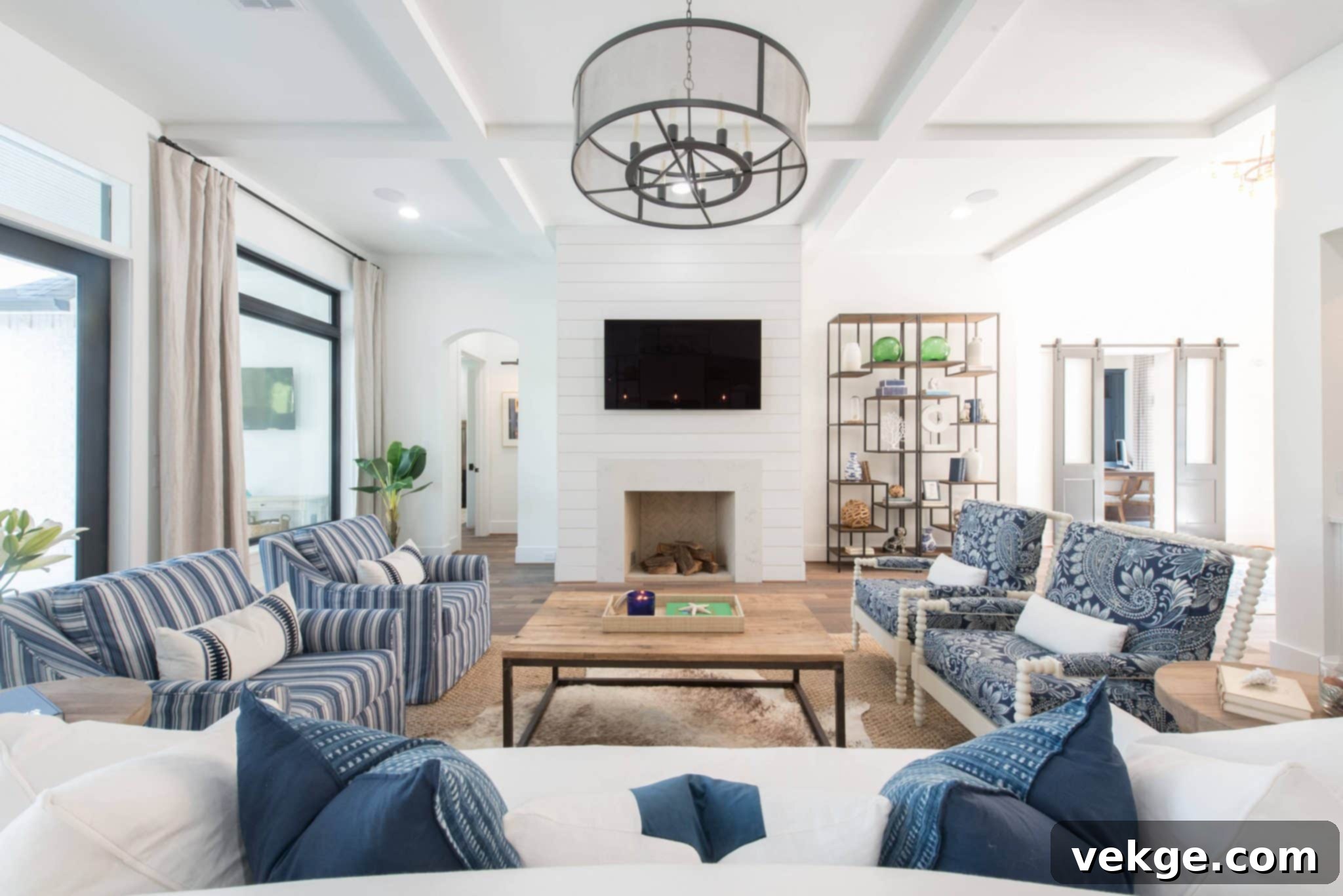Transform Your Home: A Comprehensive Guide to Modern Coastal Interior Design
In the vast and ever-evolving landscape of interior design, a myriad of styles captures our imagination, each with its unique charm. Some embrace the sleek, innovative aesthetics of contemporary trends, while others draw profound inspiration from the natural world. Among these nature-influenced approaches, styles such as Boho, Scandinavian, and Mediterranean have garnered immense popularity. Yet, a truly distinctive and refreshing aesthetic emerges when the tranquility of nature seamlessly blends with modern sophistication: the captivating Modern Coastal design style.
This sophisticated design philosophy transcends the traditional, often kitschy, beach house look, offering a refined interpretation of seaside living that can be embraced in any home, regardless of its proximity to the ocean. It’s about inviting the calming essence of coastal beauty – the warmth of sun-drenched beaches, the expansive blue of the sky, and the gentle rhythm of the waves – into your personal sanctuary. If you yearn for an interior that feels both elegant and effortlessly relaxed, creating a serene escape from the everyday, the modern coastal aesthetic might be your perfect match.
To fully appreciate and effectively implement this beautiful style, it’s essential to understand its core principles and distinguishing characteristics. We’ve meticulously crafted this guide to describe the modern coastal design style in detail, providing you with all the insights needed to transform your space. Let’s delve into what makes this particular style so enchanting and how it can bring a breath of fresh, sea-scented air into your home.
What Exactly is Modern Coastal Design Style?

The coastal design style has a storied history in interior decorating, undergoing significant variations over time. While it shares foundational elements with other nature-inspired and minimalist aesthetics like Scandinavian design – such as an appreciation for natural materials, clean lines, and soft color palettes – modern coastal design distinguishes itself with its unique emphasis on creating a refined, yet inviting, beach-inspired atmosphere. It’s a style that has matured beyond quaint nautical themes, offering a sophisticated and tranquil living experience that feels both current and timeless.
At its core, modern coastal design draws deeply from the breathtaking elements of coastal environments: the expansive oceans, sun-kissed beaches, endless skies, soft sands, invigorating salty air, dynamic surf, and the subtle allure of seashells. These natural factors are not merely decorative afterthoughts; they are the foundational inspiration for selecting color palettes, materials, textures, and fabrics. Unlike traditional coastal styles that might lean heavily into overt maritime motifs or a cluttered aesthetic, modern coastal is about capturing the essence and feeling of the coast in a more understated, elegant, and harmonious manner.
Crucially, this contemporary interpretation of coastal living is no longer confined solely to beachfront properties. Its inherent adaptability allows it to infuse any space – from bustling urban apartments to peaceful countryside homes – with a serene, airy, and sophisticated ambiance reminiscent of the seaside. It’s about cultivating an environment that feels light, open, and utterly refreshing, bringing the tranquil beauty and relaxed elegance of the coast directly into your everyday life. This design style possesses a distinct essence that truly makes it stand apart. Let’s explore these captivating features in greater detail.
Fascinating Features of the Modern Coastal Design Style
Every interior design aesthetic is built upon a unique set of inspirational aspects, and the modern coastal style is no exception. Its design development is intricately woven around elements that evoke the peace, serenity, and unparalleled beauty of the seaside. Here are the defining characteristics that bring this exquisite style to life, offering a blueprint for achieving its distinctive charm:
1. Influential Coastal Color Tones

The color palette is arguably the most defining element of modern coastal design. Interior decor experts consistently recommend a base of warm, neutral tones to create the expansive and inviting feeling of a seashore. Think beyond just stark white; shades like soft beige, creamy off-white, light greys, and natural browns form the perfect canvas. These neutrals create a foundational sense of calm and allow other elements to subtly shine, reflecting the natural light of a sun-drenched beach.
To truly capture the essence of the ocean and sky, these neutrals are beautifully complemented by cool, soothing shades of blue and green. From tranquil aquas and seafoam greens to deeper navy blues and muted teals, these colors directly evoke the water and horizon, significantly enhancing the bright, airy, and utterly relaxing coastal atmosphere. Strategic use of these hues can transform a room, making it feel more open, serene, and deeply connected to nature. It’s crucial to avoid overly bright or primary colors, instead opting for muted, dusty, or desaturated versions that mimic natural coastal light and shadows for an authentic feel.
2. Embraces Abundant Natural Light

In modern coastal interiors, natural light is not merely preferred; it’s an absolute imperative and a cornerstone of the aesthetic. This design philosophy thrives on maximizing sun exposure, making spaces feel open, expansive, and vibrantly alive. Designers and architects often emphasize the inclusion of large windows, sliding glass doors, and open-plan layouts to flood rooms with abundant daylight. The overarching goal is to create an uninterrupted visual and atmospheric flow between the indoors and outdoors, mimicking the vastness and unrestricted feel of the seaside landscape.
To further enhance this luminous effect, heavy or opaque window treatments are typically avoided. Instead, opt for sheer curtains, lightweight linen panels, or simple, unobtrusive blinds that can be easily drawn back to welcome the sun’s rays. Mirrors are strategically placed to reflect light and expand the visual space, further brightening the room and creating an illusion of greater depth. The dynamic interplay of natural light with the soft, reflective coastal color palette creates a truly captivating and uplifting environment that feels inherently fresh and open.
3. Extra Comfy and Sustainable Furniture Choices

Comfort, durability, and a connection to natural materials are paramount in modern coastal design furniture. Pieces should invite relaxation and feel welcoming, yet maintain a sophisticated and uncluttered aesthetic. Trending choices include generously sized, slip-covered sofas and armchairs in lighter, washable fabrics, offering both impeccable style and practical ease of maintenance. Whitewashed or light-stained wooden furniture, particularly those with a slightly distressed or reclaimed look, blend seamlessly with the aesthetic, adding character and warmth without being overly rustic or ornate.
Beyond traditional wood, materials like wicker, rattan, and bamboo are excellent choices, bringing natural texture and an organic, breezy feel to the space. These materials are not only sustainable and eco-friendly but also contribute significantly to the relaxed, vacation-like vibe. Look for simple, clean-lined designs that prioritize function and comfort. The aim is to create a living space that feels lived-in, loved, and effortlessly inviting, much like a favorite seaside retreat where you can truly unwind.
4. Abundant Use of Natural Fabrics

Texture plays a crucial and often understated role in modern coastal interiors, largely delivered through the thoughtful selection of natural fabrics. Organic cotton and linen are highly favored, especially in pale and muted shades, for their exceptional breathability, soft drape, and casual elegance. Cotton is ideal for durable slipcovers, plush cushion covers, inviting throw pillows, and cozy blankets, providing comfort and a relaxed look that easily withstands daily life and is simple to care for.
Linen, with its characteristic subtle slubs and beautiful natural texture, is perfect for curtains, creating a soft, ethereal diffusion of light and a soothing, airy environment. Beyond these staples, jute and wool fabrics integrate beautifully into the scheme, particularly for area rugs, mats, and woven accents. These materials add earthy, grounding textures that enhance the organic feel of the space, creating a rich tactile experience. These natural fibers contribute significantly to an overall sense of tranquility, comfort, and authenticity, reminiscent of soft sand and gentle ocean breezes.
5. Thoughtful, Minimalistic Decor

While often described as minimalistic, modern coastal decor is more accurately characterized as thoughtful, curated, and purposeful. The underlying philosophy is to avoid clutter and instead focus on a few select pieces that resonate deeply with the coastal theme without being overly thematic or kitschy. Experts often suggest incorporating roughly structured, non-glossy, or slightly darker decor items to create subtle yet impactful accents against an otherwise light and airy backdrop, providing visual anchor points.
Think beyond typical seashell collections or overt nautical symbols. Instead, incorporate ocean-inspired art pieces like elegantly displayed driftwood, abstract paintings evoking serene seascapes, or subtle ombre-toned decorative items that mimic the fading light of the sky or ocean’s depth. Woven decor pieces, hand-thrown ceramic vases with organic shapes, and clear or colored glass elements (like recycled glass bottles or simple clear vases) add essential texture and reflection. For artificial lighting, consider brass or golden lamps with a slightly aged finish, or pendant lights crafted from natural materials like rattan or rope. Even carefully chosen DIY decor projects, such as framed pressed seaweed or a small, artfully arranged collection of smooth stones, can add a personal and authentic touch to your modern coastal space, making it uniquely yours.
6. Integrated Greenery and Plant Life

As a design style fundamentally inspired by nature, the seamless integration of beautiful plants and vibrant greenery is not just an option but a vital and non-negotiable component of modern coastal aesthetics. Plants instantly bring life, freshness, and an undeniable organic touch to any interior, powerfully reinforcing the connection to the natural world and purifying the air.
Consider adding large, architectural leafy plants like fiddle-leaf figs, kentia palms, or olive trees for a touch of tropical lushness or Mediterranean elegance. Smaller plants such as resilient succulents, delicate air plants, or lush ferns can be artfully displayed in woven baskets, handcrafted ceramic pots, or simple glass terrariums. These elements not only enhance the visual beauty of the space but also contribute significantly to a sense of calm and well-being, purifying the air and adding vibrant, living touches of natural color against the serene coastal palette. Thoughtfully chosen greenery ensures that the “nature” in “nature-inspired” is truly felt and experienced throughout the home, creating a living, breathing sanctuary.
The modern coastal design style is celebrated for its subtle elegance, profound comfort, and profoundly welcoming ambiance. It masterfully achieves an ocean-inspired atmosphere without demanding high-end or excessively expensive elements. However, to truly perfect this serene aesthetic and ensure its longevity, a few practical considerations and actionable tips should be kept firmly in mind.
Useful Tips to Embrace Coastal Hues and Vibes
Creating a truly authentic and comfortable modern coastal interior involves more than just selecting the right colors and furniture. It’s about cultivating an entire sensory experience and lifestyle. Here are some actionable tips to help you infuse your home with delightful coastal hues and tranquil, beach-inspired vibes, turning your space into a true haven:
- Prioritize Practicality and Comfort: Opt for comfortable, easy-to-maintain, and washable elements wherever possible. This includes choosing durable fabrics like cotton and linen for upholstery and slipcovers, which can withstand regular use and cleaning, making your home truly livable. Select furniture that is both stylish and practical for everyday living, ensuring your space is as functional as it is beautiful.
- Embrace Openness, Avoid Clutter: The essence of coastal living is intrinsically associated with spaciousness, fresh air, and an uncluttered mind. Resist the urge to over-decorate or fill every surface. A minimalistic and intentional approach, focusing on quality over quantity, will help maintain an airy, serene, and uncluttered feel. Each item should have a clear purpose or contribute significantly to the aesthetic.
- Leverage the Power of White: White, in its various soft and warm tones, is a cornerstone of modern coastal design. Use it generously on walls, ceilings, and even large furniture pieces to create a bright, expansive backdrop. White not only maximizes natural light and enhances the feeling of openness but also serves as a crisp, clean canvas, allowing the blues, greens, and natural textures to truly pop, giving the illusion of a larger, more breathable space.
- Introduce Thoughtful Accents: While the primary palette is soft and serene, strategic use of bold decor pieces, unique artificial light fixtures, or distinctive hardware can add depth, visual interest, and personality. Consider a single statement piece of art that incorporates a deeper ocean blue or a vibrant coral hue, a beautifully crafted brass or matte black lamp with a vintage or industrial feel, or a textured ceramic vase in a sandy tone to create focal points without overwhelming the space.
- Engage All Your Senses: If your home isn’t surrounded by actual coastal areas, you can still evoke the seaside experience through carefully chosen sensory details. Use specific scents like marine, sea salt, fresh linen, or subtle coconut-scented candles or diffusers. Play ambient music featuring gentle ocean waves or soft, relaxing melodies. Introduce bowls of smooth sea glass, a small collection of sustainably sourced shells, or a piece of polished driftwood to touch, bringing tactile elements of the beach indoors.
- Consider Flooring Carefully: The right flooring can significantly impact the coastal feel. Hardwood floors in light tones, whitewashed or limewashed planks, or large-format tiles that mimic sand or natural stone are ideal choices. Area rugs made from natural fibers like jute, sisal, or wool in neutral tones can define zones, add warmth, and introduce crucial texture underfoot, enhancing comfort and visual appeal.
- Layer Textures for Depth: Modern coastal design is rich in subtle textures. Combine smooth ceramics with rough woven baskets, soft linen throws and pillows with sturdy wooden furniture, and sparkling glass accents with natural stone or untreated wood. This thoughtful layering adds depth, interest, and a luxurious tactile experience without relying on excessive patterns or loud colors, creating a truly inviting environment.
Conclusion
Nature-inspired design styles possess an evergreen appeal, consistently imbuing spaces with unique elegance, profound tranquility, and a timeless quality. Among these, the modern coastal design style stands out for its complete embrace of natural, beachy vibes, refined and adapted for contemporary living. It creates an atmosphere of unparalleled serenity, sophisticated comfort, and effortless charm, transforming any home into a peaceful retreat. However, it’s common for this distinct style to be confused with other minimalist or nature-centric aesthetics due to some shared elements, often leading to a misunderstanding of its unique identity and potential.
This comprehensive article has aimed to precisely define the modern coastal design style, meticulously describing its key features and underlying philosophy to help you acknowledge and implement this authentic aesthetic. We’ve explored everything from the influential color palettes that mimic the ocean and sky, to the crucial role of abundant natural light, the selection of comfortable and sustainable furniture, the use of organic fabrics, the art of thoughtful decor items, and the vital integration of refreshing greenery. Along with these in-depth insights, we’ve shared a range of practical tips to help you effortlessly infuse your home with those coveted coastal hues and serene, calming vibes.
We trust that this guide has clarified any doubts you may have had about modern coastal interior design, empowering you with the knowledge and inspiration to create a beautiful, tranquil, and distinctly coastal-inspired sanctuary in your own home. Embrace the calm, the light, and the organic beauty of the seaside, and let your living space become a testament to relaxed sophistication, wherever you may be.
